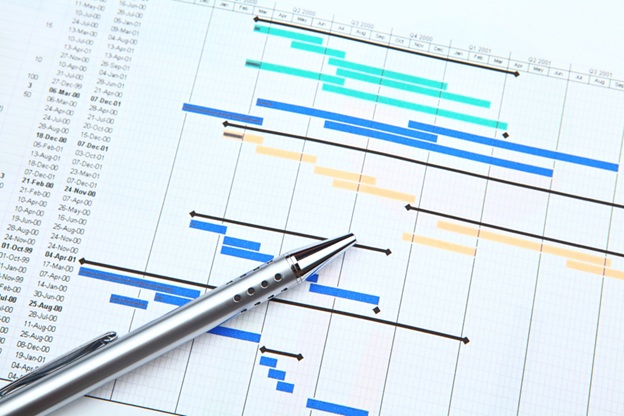Imagine being handed just one section of a puzzle without seeing the final picture. You know what you’re supposed to do, but you have no idea how your part fits into the bigger design. That’s exactly how many team members feel when they’re given project tasks without a clear timeline.
A well-built project timeline solves this problem. It shows everyone where their work fits, which tasks come before or after theirs, and how each milestone leads toward the final goal. For project managers, building this timeline is one of the most important responsibilities—but it’s not always simple. It requires understanding the overall project goals, knowing each team member’s capacity, and constantly monitoring progress.
The good news is, you don’t have to start from scratch every time. By following these five practical tips, you can create timelines that keep projects organized, teams aligned, and deadlines realistic.
1. Choose the Right Timeline Format
Just as using the right tool makes a job easier, choosing the right type of project timeline can make or break your planning. Not every project is the same, so it helps to match the timeline format to the project’s complexity.
What all timeline tools have in common:
- They lay out deliverables in order, showing how tasks connect.
- They display tasks visually so team members can quickly see what’s next.
- They highlight milestones and end dates to track progress.
Popular timeline formats include:
- Gantt Charts: Great for showing task dependencies, start and end dates, and overlapping work. However, they can get complicated for large projects.
- Kanban Boards: Ideal for visualizing workflows and tracking tasks in real time. Best for ongoing work rather than projects with strict deadlines.
- Bar (Vertical) Charts: Simple and effective for high-level overviews, but they lack detail for complex projects.
- Historical Timelines: Useful for learning from past projects, but not as helpful for managing current ones.
Experiment with different formats to see which one fits your team’s style and project needs. Tools like Accelo bring these options into one dashboard, giving you both big-picture and detailed views in the same place.
2. Define the Project Scope Clearly
Before you create a timeline, you need to fully understand what the project involves. This means analyzing goals, deliverables, and tasks in detail.
How to define scope effectively:
- Collaborate with clients or stakeholders: Ask questions until you’re sure you understand the big picture.
- Identify milestones: These are the major checkpoints that show progress, such as approvals or finished deliverables.
- Break down milestones into tasks: Smaller, detailed steps make the timeline easier to manage.
- Set realistic time estimates: Factor in risks and possible delays.
- Write a scope statement: Document the objectives, tasks, and milestones so everyone is aligned.
When you also share a milestone list with due dates, you set clear expectations early and avoid misunderstandings later.
3. Communicate With Your Team
Even the best project timeline won’t work if the team isn’t on the same page. Strong communication ensures everyone knows their role, their deadlines, and how their work connects to the bigger project.
Tips for better communication:
- Use project management tools that allow real-time updates and messaging.
- Keep communication clear and focused—give people the information they need for their tasks without overloading them.
- Create shared task lists so the whole team has visibility.
- Be mindful of team bandwidth—.if someone is overloaded, adjust before deadlines become a problem.
Regular check-ins and status updates prevent surprises and help you adjust the timeline if needed.
4. Use Project Software That Fits Your Industry
Not all project management software is built the same. A healthcare business, for example, needs different tools than a marketing agency. Choosing software that fits your industry can save time and make timelines easier to follow.
Look for software with features such as:
- Support for multiple timeline formats (Gantt, Kanban, etc.)
- Scalability so you can start simple and add features as projects grow
- Easy progress tracking with dashboards and reports
- Automatic updates and ongoing support
- Customization options for workflows and templates
- Integration with tools you already use (like Excel, Jira, or email)
- Time tracking to monitor workload and budgets
- Real-time communication to keep teams connected
With the right software, you can reduce manual work, streamline communication, and stay on top of every detail.
5. Assign Tasks—Then Step Back
As a project manager, your job is to build the plan, assign responsibilities, and make sure everyone has what they need. But once tasks are assigned, it’s important to trust your team and avoid micromanaging.
How to stay involved without hovering:
- Use dashboards to monitor overall progress.
- Do regular but focused check-ins.
- Perform quality checks at key stages.
- Keep communication open so team members feel comfortable raising issues.
- Hold short, to-the-point meetings to address concerns.
By giving your team ownership of their tasks, you’ll build trust and keep productivity high.
Final Thoughts
Project timelines are more than just schedules—they’re roadmaps that keep everyone moving in the same direction. By choosing the right format, defining the scope, maintaining strong communication, using the right software, and balancing oversight with trust, you can create timelines that guide your team to success.
When managed well, timelines don’t just keep projects on track—they also reduce stress, improve collaboration, and give both clients and teams confidence in the process.

